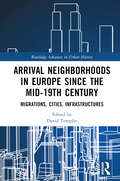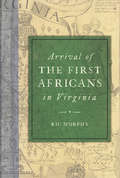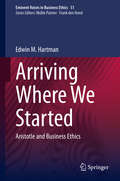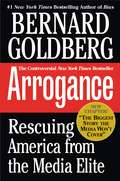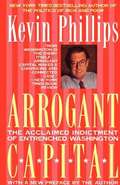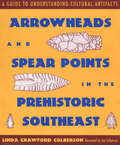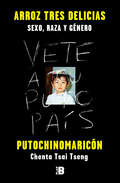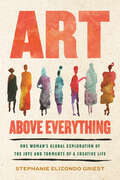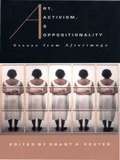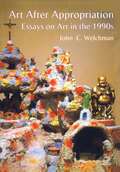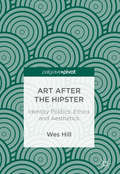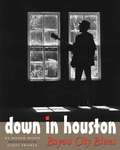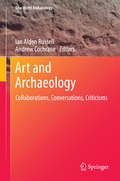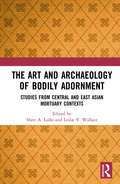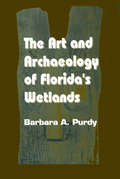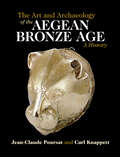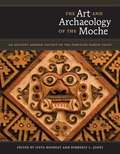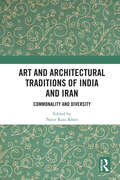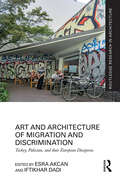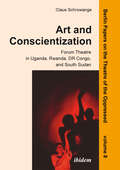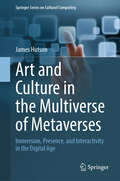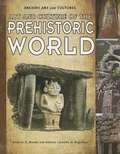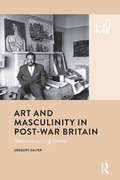- Table View
- List View
Arrival Neighborhoods in Europe since the mid-19th Century: Migrations, Cities, Infrastructures (ISSN)
by David TemplinThis book uses the concept of "arrival spaces" to examine the relationship between migration processes, social infrastructures, and the transformation of urban spaces in Europe since the mid-19th century.Case studies cover cities from London to Palermo and from Antwerp to St. Petersburg, including both metropolises and small towns. The chapters examine the emergence of settlement patterns, the functioning of arrival infrastructures, and the public representations of neighborhoods which have been shaped by internal or international migrations. By understanding these neighborhoods as spaces of arrival and as infrastructural hubs, this volume offers a new perspective on the profound impact of migration on European cities in modern and contemporary history.This volume makes a valuable contribution to both migration research and urban history and will be of interest to researchers and students studying the relationship between cities and migration in Europe’s past and present.
Arrival of the First Africans in Virginia (American Heritage)
by Ric MurphyIn 1619, a group of thirty-two African men, women and children arrived on the shores of Virginia. They had been kidnapped in the royal city of Kabasa, Angola, and forced aboard the Spanish slave ship San Juan Bautista. The ship was attacked by privateers, and the captives were taken by the English to their New World colony. This group has been shrouded in controversy ever since. Historian Ric Murphy documents a fascinating story of colonialism, treason, piracy, kidnapping, enslavement and British law.
Arriving Where We Started: Aristotle and Business Ethics (Issues in Business Ethics #51)
by Edwin M. HartmanEdwin Hartman offers an account of his intellectual journey from Aristotle to organization theory to business ethics to an Aristotelian approach to business ethics. Aristotle’s work in metaphysics and psychology offers some insights into the explanation of behavior. Central to this sort of explanation is characteristically human rationality. Central to successful organizations is characteristically human sociability. That human beings are by nature rational and sociable is the basis of Aristotle’s ethics. Though a modern organization is not a polis in Aristotle’s sense, it has good reason to treat people as rational and sociable on the whole, and thereby to preserve the organization as a commons of people linked by something much like Aristotle’s account of strong friendship. Organizations that are successful in this respect, particularly those that deal with a nationally diverse workforce, may offer a far-reaching and attractive model.
Arrogance: Rescuing America from the Media Elite
by Bernard GoldbergFormer CBS News correspondent Goldberg cites example after example of what he identifies as distorted reporting and asserts that these examples prove the pervasiveness of a liberal bias in the mainstream media. His credibility is diminished by a breathless, scattershot approach and sketchy documentation of examples (many taken out of context); but his points seem to be that attuned citizens will find such examples everywhere they look and that honest journalists should open their eyes. He includes a section of contact information for conservative organizations and think tanks.There is no bibliography. Annotation ©2004 Book News, Inc., Portland, OR (booknews.com)
Arrogant Capital: Washington, Wall Street, and the Frustration of American Politics
by Kevin PhillipsEveryone knows that Washington is completely out of touch with the rest of the country. Now Kevin Phillips, whose bestselling books have prophesied the major watersheds of American party politics, tells us why. Washington - mired in bureaucracy, captured by the money power of Wall Street, and dominated by 90,000 lobbyists, 60,000 lawyers, and the largest concentration of special interests the world has ever seen - has become the albatross that Thomas Jefferson and our other Founding Fathers feared: a swollen capital city feeding off the country it should be governing. Throughout most of our history, the genius of American politics was that ballot revolutions every generation swept out failed establishments and created new ones. Now that can no longer happen. Feared and even hated by a majority of the citizenry, "Permanent Washington" has dug in. Using history as a chilling warning, Kevin Phillips parallels the present atrophy to that of formerly mighty and arrogant capitals like Rome, Madrid, and Amsterdam.,Unchecked, Washington will - like other great powers before it - lead the country to its inevitable decline and fall. To work again, Washington must be purged and revitalized. In his unique blueprint for a political upheaval, Kevin Phillips puts Washington on notice by sounding a cry for immediate action, offering us a wide variety of remedies - some quasi-revolutionary, others more moderate, but all sure to be controversial.
Arrowheads and Spear Points in the Prehistoric Southeast: A Guide to Understanding Cultural Artifacts
by Linda Crawford CulbersonThe Native American tribes of what is now the southeastern United States left intriguing relics of their ancient cultural life. Arrowheads, spear points, stone tools, and other artifacts are found in newly plowed fields, on hillsides after a fresh rain, or in washed-out creek beds. These are tangible clues to the anthropology of the Paleo-Indians, and the highly developed Mississippian peoples. This indispensable guide to identifying and understanding such finds is for conscientious amateur archeologists who make their discoveries in surface terrain. Many are eager to understand the culture that produced the artifact, what kind of people created it, how it was made, how old it is, and what its purpose was. Here is a handbook that seeks identification through the clues of cultural history. In discussing materials used, the process of manufacture, and the relationship between the artifacts and the environments, it reveals ancient discoveries to be not merely interesting trinkets but by-products from the once vital societies in areas that are now Alabama, Arkansas, Georgia, Kentucky, Louisiana, Mississippi, the Carolinas, as well as in southeastern Texas, southern Missouri, southern Illinois, and southern Indiana. The text is documented by more than a hundred drawings in the actual size of the artifacts, as well as by a glossary of archeological terms and a helpful list of state and regional archeological societies.
Arroz Tres Delicias: Sexo, raza y género
by PutochinomaricónUn himno reivindicativo contra la discriminación. «El plato tiene su origen en Estados Unidos, cuando los chinoamericanos que trabajaban y eran explotados en la construcción del Ferrocarril Transcontinental, por supervivencia, recogían las sobras de comida que tiraban los jefes de la obra. Y con esos restos y la cantidad de arroz que les daban diariamente, crearon el arroz tres delicias. »Siento que todos los que hemos sido considerados minorías compartimos una historia parecida. Con las sobras, los restos, los escupitajos, el racismo, la misoginia y la homofobia nos hicieron pedacitos, pero luego nos recompusimos y nos hicimos más fuertes. Este libro trata sobre ese momento crucial en el que uno decide deconstruirse y apropiarse de esos pedacitos.»
Art Above Everything: One Woman's Global Exploration of the Joys and Torments of a Creative Life
by Stephanie Elizondo GriestMeet queer, BIPOC, and women artists around the world as they discuss the gifts, costs, and redemptive power of pursuing a creative lifeIs the all-encompassing quest to become a self-sustaining artist worth the sacrifices it often requires? Throughout her 20s and 30s, Stephanie Elizondo Griest could not help worrying if constantly prioritizing her writing over everything else—from postponing children to living nomadically to save on rent—was leading her to fulfillment or regret. After a break-up and serious health crisis in her early 40s, she decided to turn to other women artists for their perspectives on that perennial question: is art enough?Art Above Everything introduces us to legendary writers, visual artists, dancers, and musicians across the globe, who talk intimately about their art, what it requires, what it gifts them, and what it costs them. Opening in a classical Indian dance village, Elizondo Griest goes on to meet 100+ artists in Rwanda, Romania, Qatar, Iceland, Mexico, New Zealand, Cuba, and the United States. She discovers artists from Rwandan playwright Hope Azeda, who navigated ethnic tensions as she attempted to bring about reconciliation through theater in the aftermath of genocide; to Romanian painter Florica Prevenda, who got assigned to a provincial factory during Ceaușescu&’s dictatorship but never relinquished her brushes.Art is inheritance, dissent, devotion, revenge, celebration, and more. Yet though each artist&’s relationship to their craft is different, their need to create in the face of economic hardship, misogyny, sexual violence, and family ostracization is wholly akin.Bold and inspiring, Art Above Everything never pretends that the artist&’s path is easy—but it illuminates the infinite ways we can wield creativity as a vitalizing force.
Art, Activism, and Oppositionality: Essays from Afterimage
by Grant H. KesterThere is a common perception in the arts today that overtly activist artæoften seen to sacrifice an aesthetic pleasure for a subversive oneæis no longer in fashion. In bringing together sixteen of the most important essays on activist and community-based art from the pages of Afterimageæone of the most influential journals in the media and visual arts fields for more than twenty-five yearsæGrant H. Kester demonstrates that activist art, far from being antithetical to the true meaning of the aesthetic, can be its most legitimate expression.Forging a style of criticism where aesthetic, critical, theoretical, and activist concerns converge, Afterimage has shaped American debates around the politics of visual production and arts education while offering a voice to politically involved artists and scholars. Art, Activism, and Oppositionality insists not only on the continuing relevance of an activist stance to contemporary art practice and criticism, but also on the significance of an engaged art practice that is aligned with social or political activism. With essays that span fifteen yearsæroughly from Ronald Reagan's 1980 presidential win to the 1994 Republican victories in Congress, a period marked by waning public support for the arts and growing antagonism toward activist art æArt, Activism, and Oppositionality confronts issues ranging from arts patronage, pedagogy, and the very definitions of art and activism to struggles involving AIDS, reproductive rights, sexuality, and racial identity.Art, Activism, and Oppositionality will interest students and scholars of contemporary art history, media studies, cultural studies, and the fine arts, as well as, arts activists, critics, and arts administrators.Contributors. Maurice Berger, Richard Bolton, Ann Cvetkovich, Coco Fusco, Brian Goldfarb, Mable Haddock, Grant H. Kester, Ioannis Mookas, Chiquita Mullins Lee, Darrell Moore, Lorraine O'Grady, Michael Renov, Martha Rosler, Patricia Thomson, David Trend, Charles A. Wright Jr., Patricia R. Zimmerman
Art After Appropriation: Essays on Art in the 1990s
by John C. WelchmanBeginning with the first comprehensive account of the discourse of appropriation that dominated the art world in the late 1970s and 1980s, Art After Appropriation suggests a matrix of inflections and refusals around the culture of taking or citation, each chapter loosely correlated with one year of the decade between 1989 and 1999. The opening chapters show how the Second World culture of the USSR gave rise to a new visibility for photography during the dissolution of the Soviet Union around 1989. Welchman examines how genres of ethnography, documentary and travel are crossed with fictive performance and social improvisation in the videos of Steve Fagin. He discusses how hybrid forms of subjectivity are delivered by a new critical narcissism, and how the Korean-American artist, Cody Choi converts diffident gestures of appropriation from the logic of material or stylistic annexation into continuous incorporated events. Art After Appropriation also examines the creation of public art from covert actions and social feedback, and how bodies participate in their own appropriation. Art After Appropriation concludes with the advent of the rainbow net, an imaginary icon that governs the spaces of interactivity, proliferation and media piracy at the end of the millennium.John Welchman is Professor of Modern Art History, Theory and Criticism at the University of California, San Diego. He is the author of Modernism Relocated (1995) and Invisible Colors (1997); and editor of Rethinking Borders (1996), and a forthcoming three-volume anthology of the writings of LA artist MIke Kelley. Welchman has contributed to numerous journals, magazines, museum catalogues and newspapers, including Artforum; New York Times; Los Angeles Times; International Herald Tribune; Los Angeles County Museum of Art; Tate Gallery; Museum of Contemporary Art, Los Angeles; Reina Sofia, Madrid; Haus der Kunst, Munich
Art after the Hipster: Identity Politics, Ethics and Aesthetics
by Wes HillThis book examines the complexities of the hipster through the lens of art history and cultural theory, from Charles Baudelaire's fl#65533;neur to the contemporary "creative" borne from creative industries policies. It claims that the recent ubiquity of hipster culture has led many artists to confront their own significance, responding to the mass artification of contemporary life by de-emphasising the formal and textual deconstructions so central to the legacies of modern and postmodern art. In the era of creative digital technologies, long held characteristics of art such as individual expression, innovation, and alternative lifestyle are now features of a flooded and fast-paced global marketplace. Against the idea that artists, like hipsters, are the "foot soldiers of capitalism", the institutionalized networks that make up the contemporary art world are working to portray a view of art that is less a discerning exercise in innovative form-making than a social platform--a forum for populist aesthetic pleasures or socio-political causes. It is in this sense that the concept of the hipster is caught up in age-old debates about the relation between ethics and aesthetics, examined here in terms of the dynamics of global contemporary art.
Art Against Dictatorship: Making and Exporting Arpilleras Under Pinochet
by Jacqueline AdamsArt can be a powerful avenue of resistance to oppressive governments. During the dictatorship of Augusto Pinochet in Chile, some of the country's least powerful citizens-impoverished women living in Santiago's shantytowns-spotlighted the government's failings and use of violence by creating and selling arpilleras, appliquéd pictures in cloth that portrayed the unemployment, poverty, and repression that they endured, their work to make ends meet, and their varied forms of protest. Smuggled out of Chile by human rights organizations, the arpilleras raised international awareness of the Pinochet regime's abuses while providing income for the arpillera makers and creating a network of solidarity between the people of Chile and sympathizers throughout the world. Using the Chilean arpilleras as a case study, this book explores how dissident art can be produced under dictatorship, when freedom of expression is absent and repression rife, and the consequences of its production for the resistance and for the artists. Taking a sociological approach based on interviews, participant observation, archival research, and analysis of a visual database, Jacqueline Adams examines the emergence of the arpilleras and then traces their journey from the workshops and homes in which they were made, to the human rights organizations that exported them, and on to sellers and buyers abroad, as well as in Chile. She then presents the perspectives of the arpillera makers and human rights organization staff, who discuss how the arpilleras strengthened the resistance and empowered the women who made them.
Art and Archaeology: Collaborations, Conversations, Criticisms (One World Archaeology #11)
by Ian Alden Russell Andrew CochraneThis volume presents a collection of interdisciplinary collaborations between contemporary art, heritage, anthropological, and archaeological practitioners. Departing from the proceedings of the Sixth World Archaeological Congress's 'Archaeologies of Art' theme and Ábhar agus Meon exhibitions, it includes papers by seminal figures as well as experimental work by those who are exploring the application of artistic methods and theory to the practice of archaeology. Art and archaeology: collaborations, conversations, criticisms encourages the creative interplay of various approaches to 'art' and 'archaeology' so these new modes of expression can contribute to how we understand the world. Established topics such as cave art, monumental architecture and land art will be discussed alongside contemporary video art, performance art and relational arts practices. Here, the parallel roles of artists as makers of new worlds and archaeologists as makers of pasts worlds are brought together to understand the influences of human creativity.
The Art and Archaeology of Ancient Greece
by Judith M. BarringerThe Art and Archeology of Ancient Greece is an introductory-level textbook for students with little or no background in ancient art. Arranged chronologically in broad swathes of time, from the Bronze and Iron Ages through the Geometric, Archaic, Classical, and Hellenistic periods, and concluding with the Roman conquest of the Greek world, the textbook focuses on Greek art but also incorporates Near Eastern, Etruscan, and Roman objects. Judith M. Barringer examines a variety of media, analyzing marble and bronze sculpture, public architecture, and vase painting, as well as coins, domestic architecture, mosaics, terracotta figurines and reliefs, jewelry, and wall painting. This book adopts an approach that considers objects and monuments within their cultural contexts. * More than 500 illustrations, with over 400 in color and 13 maps, including specially commissioned photographs, maps, plans, and reconstructions * Includes text boxes, chapter summaries and timelines, and detailed glossary * Looks at Greek art from perspectives of both art history and archaeology, giving students an understanding of the historical and everyday context of art objects
The Art and Archaeology of Bodily Adornment: Studies from Central and East Asian Mortuary Contexts
by Sheri A. Lullo Leslie V. WallaceThe Art and Archaeology of Bodily Adornment examines the significance of adornment to the shaping of identity in mortuary contexts within Central and East Asia and brings these perspectives into dialogue with current scholarship in other worldwide regions. Adornment and dress are well-established fields of study for the ancient world, particularly with regard to Europe and the Americas. Often left out of this growing discourse are contributions from scholars of Central and East Asia. The mortuary contexts of focus in this volume represent unique sites and events where identity was visualized, and often manipulated and negotiated, through material objects and their placement on and about the deceased body. The authors examine ornaments, jewelry, clothing, and hairstyles to address questions of identity construction regarding dimensions such as gender and social and political status, and transcultural exchange from burials of prehistoric and early historical archaeological sites in Central Asia, China, Korea, and Japan. In both breadth and depth, this book will be of interest to students and scholars interested in the archaeology, art, and history of Central and East Asia, as well as anyone interested in the general study of dress and adornment.
Art and Archaeology of Challuabamba, Ecuador
by Terence GriederChalluabamba (chī-wa-bamba)--now a developing suburb of Cuenca, the principal city in the southern highlands of Ecuador--has been known for a century as an ancient site that produced exceptionally fine pottery in great quantities. Suspecting that Challuabamban ceramics might provide a link between earlier, preceramic culture and later, highly developed Formative period art, Terence Grieder led an archaeological investigation of the site between 1995 and 2001. In this book, he and the team of art historians and archaeologists who excavated at Challuabamba present their findings, which establish the community's importance as a center in a network of trade and artistic influence that extended to the Amazon River basin and the Pacific Coast. Art and Archaeology of Challuabamba, Ecuador presents an extensive analysis of ceramics dating to 2100-1100 BC, along with descriptions of stamps and seals, stone and shell artifacts, burials and their offerings, human remains, and zooarchaeology. Grieder and his coauthors demonstrate that the pottery of Challuabamba fills a gap between early and late Formative styles and also has a definite connection with later highland styles in Peru. They draw on all the material remains to reconstruct the first clear picture of Challuabamba's prehistory, including agriculture and health, interregional contacts and exchange, red-banded incised ware and ceramic production, and shamanism and cosmology. Because southern Ecuador has received relatively little archaeological study, Art and Archaeology of Challuabamba, Ecuador offers important baseline data for what promises to be a key sector of the prehistoric Andean region.
The Art and Archaeology of Florida's Wetlands
by BarbaraA. PurdyWaterlogged archaeological sites in Florida contain tools, art objects, dietary items, human skeletal remains, and glimpses of past environments that do not survive the ravages of time at typical terrestrial sites. Unfortunately, archaeological wet sites are invisible since their preservation depends upon their entombment in oxygen-free, organic deposits. As a result, they are often destroyed accidentally during draining, dredging, and development projects. These sites and the objects they contain are an important part of Florida's heritage. They provide an opportunity to learn how the state's earliest residents used available resources to make their lives more comfortable and how they expressed themselves artistically. Without the wood carvings from water-saturated sites, it would be easy to think of early Floridians as culturally impoverished because Florida does not have stone suitable for creating sculptures. This book compiles in one volume detailed accounts of such famous sites as Key Marco, Little Salt Spring, Windover, Ft. Center, and others. The book discusses wet site environments and explains the kinds of physical, chemical, and structural components required to ensure that the proper conditions for site formation are present and prevail through time. The book also talks about how to preserve artifacts that have been entombed in anaerobic deposits and the importance of classes of objects, such as wooden carvings, dietary items, human skeletal remains, to our better understanding of past cultures. Until now this information has been scattered in obscure documents and articles, thus diminishing its importance. Our ancestors may not have been Indians, but they contributed to the state's heritage for more than 10,000 years. Once disturbed by ambitious dredging and draining projects, their story is gone forever; it cannot be transplanted to another location.
The Art and Archaeology of the Aegean Bronze Age: A History
by Jean-Claude PoursatThe Art and Archaeology of the Aegean Bronze Age offers a comprehensive chronological and geographical overview of one of the most important civilizations in human history. Jean-Claude Poursat's volume provides a clear path through the rich and varied art and archaeology of Aegean prehistory, from the Neolithic period down to the end of the Bronze Age. Charting the regional differences within the Aegean world, his study covers the full range of material evidence, including architecture, pottery, frescoes, metalwork, stone, and ivory, all lucidly arranged by chapter. With nearly 300 illustrations, this volume is one of the most lavishly illustrated treatments of the subject yet published. Suggestions for further reading provide an up-to-date entry point to the full richness of the subject. Originally published in French, and translated by the author's collaborator Carl Knappett, this edition makes Poursat's deep knowledge of the Aegean Bronze Age available to an English-language audience for the first time.
The Art And Archaeology of the Moche: An Ancient Andean Society of the Peruvian North Coast
by Bourget Steve Jones Kimberly L.Renowned for their monumental architecture and rich visual culture, the Moche inhabited the north coast of Peru during the Early Intermediate Period (AD 100-800). Archaeological discoveries over the past century and the dissemination of Moche artifacts to museums around the world have given rise to a widespread and continually increasing fascination with this complex culture, which expressed its beliefs about the human and supernatural worlds through finely crafted ceramic and metal objects of striking realism and visual sophistication. In this standard-setting work, an international, multidisciplinary team of scholars who are at the forefront of Moche research present a state-of-the-art overview of Moche culture. The contributors address various issues of Moche society, religion, and material culture based on multiple lines of evidence and methodologies, including iconographic studies, archaeological investigations, and forensic analyses. Some of the articles present the results of long-term studies of major issues in Moche iconography, while others focus on more specifically defined topics such as site studies, the influence of El Niño/Southern Oscillation on Moche society, the nature of Moche warfare and sacrifice, and the role of Moche visual culture in decoding social and political frameworks.
Art and Architectural Traditions of India and Iran: Commonality and Diversity
by Nasir Raza KhanThis book presents a comprehensive overview of the historical and cultural linkages between India and Iran in terms of art and architectural traditions and their commonality and diversity. It addresses themes such as early connections between Iran, India and Central Asia; study of the Qutb Complex in Delhi; the great immigration of Turks from Asia to Anatolia; the collaboration of Indian and Persian painters; design, ornamentation techniques and regional dynamics; women and public spaces in Shahjahanabad and Isfahan; the noble-architects of emperor Shah Jahan's reign; development of Kashmir’s Islamic religious architecture in the medieval period; role of Nur Jahan and her Persian roots in the evolution of the Mughal Garden; synthesis of Indo-Iranian architecture; and confluence of Indo-Persian food culture to showcase the richness of art, architecture, and sociocultural and political exchanges between the two countries. Bringing together a wide array of perspectives, it delves into the roots of connection between India and Iran over centuries to understand its influence and impact on the artistic and cultural genealogy and the shared past of two of the oldest civilizations and regional powers of the world. With its archival sources, this book will be useful to scholars and researchers of medieval history, Indian history, international relations, Central Asian history, Islamic studies, Iranian history, art and architecture, heritage studies, cultural studies, regional studies, and South Asian studies as well as those interested in the study of sociocultural and religious exchanges.
Art and Architecture of Migration and Discrimination: Turkey, Pakistan, and their European Diasporas (Routledge Research in Architecture)
by Esra Akcan Iftikhar DadiThis book brings together essays by established and emerging scholars that discuss Pakistan, Turkey, and their diasporas in Europe. Together, the contributions show the scope of diverse artistic media, including architecture, painting, postcards, film, music, and literature, that has responded to the partitions of the twentieth century and the Muslim diasporas in Europe. Turkey and Pakistan have been subject to two of the largest compulsory population transfers of the twentieth century. They have also been the sites for large magnitudes of emigration during the second half of the twentieth century, creating influential diasporas in European cities such as London and Berlin. Discrimination has been both the cause and result of migration: while internal problems compelled citizens to emigrate from their countries, blatant discriminatory and ideological constructs shaped their experiences in their countries of arrival. Read together, the Partition emerges from the essays in Part I not as a pathology specific to the Balkans, Middle East, or South Asia, but as a central problematic of the new political realities of decolonization and nation formation. The essays in Part II demonstrate the layered histories and multiple migration paths that have shaped the experiences of Berliners and Londoners. This analysis furthers the study of modernism and migration across the borders of, not only the nation-state, but also class, race, and gender. As a result, this book will be of interest to a broad multidisciplinary academic audience including students and faculty, artists, architects and planners, as well as non-specialist general public interested in visual arts, architecture and urban literature.
Art and Conscientization: Forum Theatre in Uganda, Rwanda, DR Congo, and South Sudan (Berlin Papers on the Theatre of the Oppressed #8)
by Claus SchrowangeHow can the performing arts add value to peacebuilding programs? Is it possible to use participatory theatre to reconnect and reconcile enemies? What is the trauma-healing effect for those acting in a theatre troupe? <P><P>Claus Schrowange has explored these questions and the opportunities of using forum theatre in peace work in Uganda, South Sudan, Rwanda, and DR Congo. His conclusion is that forum theatre is more than mere entertainment. It is an aesthetic tool for social change. But the value of theatre is not generated automatically, the way it is done matters. If it is done in a participatory manner with an authentic, believable acting style, involving both the audience and stage actor in a vivid and touching experience, the impact is immediately felt. This book presents the approach Schrowange developed together with a team of African theatre practitioners in a variety of circumstances and environments. It is illustrated with case studies taken from the author's direct experience of using the approach he describes in Eastern DR Congo and Rwanda.
Art and Culture in the Multiverse of Metaverses: Immersion, Presence, and Interactivity in the Digital Age (Springer Series on Cultural Computing)
by James HutsonDrawing on the art historical framing of Location, Place, and Identity, this book will examine how the factors of Immersion, Presence, and Interactivity of XR are shaping our understanding of the world and our place within it. Location refers to the specific geographical or spatial context in which a work of art is created or experienced. Place refers to the social, cultural, and historical context of that location. Identity refers to the ways in which individuals and communities construct and express their sense of self and belonging within those contexts. Through case studies and theoretical analysis, Art and Culture in the Multiverse of Metaverses - Immersion, Presence, and Interactivity in the Digital Age, will explore how the factors of Immersion, Presence, and Interactivity of XR can be aligned with these art historical concepts, providing new opportunities for understanding and engaging with Location, Place, and Identity. For example, XR can be used to create immersive experiences of historical locations and cultural sites, allowing users to explore and engage with them in ways that would otherwise be impossible. Additionally, XR can be used to create interactive artworks that engage with issues of identity and belonging, creating new possibilities for self-expression and exploration.
Art And Culture Of The Prehistoric World
by Beatrice D. Brooke Roberto Carvalho de MagalhãesWe know a surprising amount about how people lived before the written word. This strikingly visual book combines photographs of artifacts created by ancient humans with brilliant illustrations, and is guaranteed to appeal to students of all ages. Readers learn about the lives of early humans, from the invention of tools to their religious beliefs. They'll see that we've been a highly inventive species all along.
Art and Masculinity in Post-War Britain: Reconstructing Home (Home Ser.)
by Gregory SalterIn this book, Gregory Salter traces how artists represented home and masculinities in the period of social and personal reconstruction after the Second World War in Britain. Salter considers home as an unstable entity at this historical moment, imbued with the optimism and hopes of post-war recovery while continuing to resonate with the memories and traumas of wartime. Artists examined in the book include John Bratby, Francis Bacon, Keith Vaughan, Francis Newton Souza and Victor Pasmore. Case studies featured range from the nuclear family and the body, to the nation. Combined, they present an argument that art enables an understanding of post-war reconstruction as a temporally unstable, long-term phenomenon which placed conceptions of home and masculinity at the heart of its aims. Art and Masculinity in Post-War Britain sheds new light on how the fluid concepts of society, nation, masculinity and home interacted and influenced each other at this critical period in history and will be of interest to anyone studying art history, anthropology, sociology, history and cultural and heritage studies.
